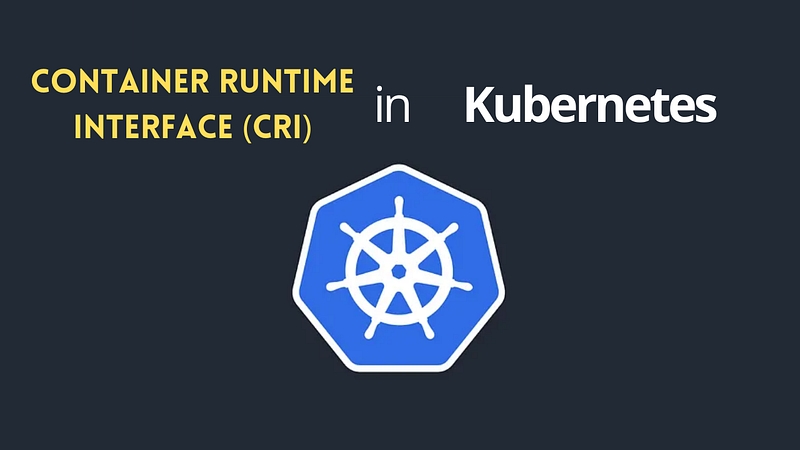Understanding Kubernetes: Part 37 Container Runtime Interface (CRI)

📢 If you’ve been following our Kubernetes series 2025, welcome back! For new readers, check out Part 36 Container Network Interface (CNI)
Container Runtime Interface (CRI) in Kubernetes
The Container Runtime Interface (CRI) is a plugin interface in Kubernetes that allows the kubelet to use different container runtimes for managing pods and containers. Kubernetes does not run containers directly; instead, it communicates with a container runtime via CRI to perform operations like pulling images, starting/stopping containers, and managing container networking.
Unlike Docker, which was directly integrated into Kubernetes in earlier versions, Kubernetes now interacts with container runtimes like containerd and CRI-O through the CRI.
Why is CRI Important?
Pluggability — Kubernetes can work with different container runtimes without modifying the kubelet.
Standardization — The CRI defines a standard API that all runtimes must implement, ensuring compatibility.
Performance — CRI-optimized runtimes (e.g., containerd, CRI-O) are lightweight and efficient compared to Docker.
Types of CRI Implementations
Kubernetes supports multiple CRI implementations, including:
containerd — A lightweight, industry-standard container runtime used by Kubernetes.
CRI-O — A Kubernetes-specific container runtime designed for Open Container Initiative (OCI) compatibility.
Docker (Legacy) — Older versions of Kubernetes supported Docker directly, but now Docker operates through dockershim (deprecated in Kubernetes 1.24).
How CRI Works in Kubernetes
The Kubernetes kubelet interacts with a container runtime via CRI using gRPC API calls. The CRI consists of two major services:
Runtime Service — Handles container lifecycle operations like creating, starting, stopping, and deleting containers.
Image Service — Manages container images, including pulling, listing, and removing images.
When a pod is scheduled, the kubelet does the following:
Calls the CRI API to pull the container image if not already available.
Requests the CRI to create and start containers within the pod.
Monitors container health via periodic CRI API calls.
Capabilities of CRI
Container Lifecycle Management — CRI enables Kubernetes to start, stop, and restart containers.
Image Management — Supports pulling, caching, and removing container images.
Networking & Storage — Ensures integration with Kubernetes networking (CNI) and storage (CSI) plugins.
Customizability — Kubernetes can switch between different CRI implementations based on requirements.
Example: Checking CRI Health
To check if CRI is functioning correctly, you can use CLI tools like crictl (for both containerd and CRI-O).
Check Container Status (For containerd & CRI-O)
This lists all running containers managed by the CRI.
Check CRI Runtime Info
This provides detailed information about the container runtime and its configuration.
Check Image List
This displays all available container images managed by the CRI.
Real-World Usage of CRI in Kubernetes
In my previous role as a DevOps Engineer, I managed Kubernetes clusters running on containerd. We ensured that the CRI was functioning correctly by:
Configuring health checks for the CRI to ensure stable cluster operations.
Monitoring runtime performance to detect issues like slow image pulls or container failures.
Switching from Docker to containerd to optimize resource utilization and improve cluster efficiency.
By leveraging CRI, we were able to enhance Kubernetes performance and reduce dependency on Docker, ensuring a more scalable and production-ready environment.
Example: YAML Configuration for a Kubernetes Pod Using CRI
Containerd Example
This pod runs on a Kubernetes cluster using containerd.
CRI-O Example
This pod runs on a Kubernetes cluster using CRI-O.
Key Takeaways
CRI allows Kubernetes to interact with container runtimes in a standardized way.
Popular CRI implementations include containerd and CRI-O.
Kubelet communicates with CRI via gRPC to manage container lifecycles and images.
You can check CRI health using
crictlcommands.Switching to containerd or CRI-O improves Kubernetes performance and reduces resource overhead.
🚀 Ready to Master Kubernetes?
Take your Kubernetes journey to the next level with the Master Kubernetes: Zero to Hero course! 🌟 Whether you’re a beginner or aiming to sharpen your skills, this hands-on course covers:
✅ Kubernetes Basics — Grasp essential concepts like nodes, pods, and services. ✅ Advanced Scaling — Learn HPA, VPA, and resource optimization. ✅ Monitoring Tools — Master Prometheus, Grafana, and AlertManager. ✅ Real-World Scenarios — Build production-ready Kubernetes setups.
🔥 Flash Sale: Buy Kubernetes Course, Get Terraform FREE! Limited Time Offer!
🔥 Start `Learning Now: [Join the Master Kubernetes Course + FREE Access to Terraform Course](https://cloudops0.gumroad.com/l/k8s)
Don’t miss your chance to become a Kubernetes expert! 💻✨
🚀 Stay ahead in DevOps and SRE! 🔔 Subscribe now and never miss a beat on Kubernetes and more. 🌟
🚀 Master Terraform: Infrastructure as Code
🔥 Start Learning Now: Join the Master Terraform Course
Apply Code DEVOPS20 for 20% OFF!
Last updated